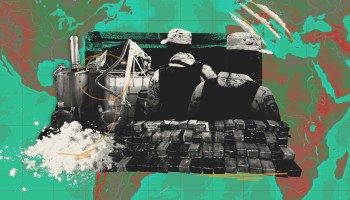Peruvian authorities are taking no chances with Serbian drug lord Zoran Jakšić. Today, he sits in a maximum-security prison dubbed “Nemesis,” which is designed to hold some of the country’s most notorious convicts.
But Jakšić didn’t end up in Peru’s most secure facility by the standard shuffling around of high-profile prisoners. Instead, he was moved to Nemesis as punishment for plotting a violent escape from his previous facility –– which almost succeeded.
A top-secret police report obtained by OCCRP, Investigace.cz, and KRIK shows that the audacious plan involved heavy weapons to attack guards and spark a prison riot, as well as a helicopter to flee the chaotic scene.
And Jakšić was not alone in the plot.
The Peruvian police report reveals how Jakšić planned the prison break along with leaders from three other major drug trafficking groups. They were all detained, but managed to stay in contact with each other and with allies outside their prison walls.
The plan only failed when –– on April Fool’s Day, 2021 –– an inmate who doubled as a police informant told his handlers that something big was about to go down at Ancon 1, the prison where three of the plotters were being held.
“The confrontation with members of the prison security will be violent and criminal,” the police report quotes the informant as saying.
By then, the criminals had already organized almost everything. All they were missing were bullets, which had been bought by organized crime groups and were set to be delivered to Ancon 1 a few days later.
At least $1 million was invested in helicopter rentals, as well as purchasing RPG-07 grenade launchers, and M-16 and AR-15 assault rifles. Three of the drug lords –– Serbian, Brazilian, and Mexican –– even temporarily stopped coordinating on drug trafficking in order to focus on the jailbreak, according to the report.
When police informed prison authorities of the plan, the group was dismantled and Jakšić was moved to Nemesis. But documents provided to reporters show just how close the plan came to fruition, and how it was put in motion by the four men, all top members of organized crime groups.
It is unclear whether all four men knew each other before they were sent to jail, although their groups had cooperated in narco-trafficking. Just how Jakšić and two of his co-conspirators ended up in the same prison at the same time — and in cahoots — is a story of cunning and criminal serendipity.
Cashing In on Peru's Cocaine Boom
In 2016, Jakšić was arrested in Peru after spending years moving between countries under as many as 40 fake identities.
Until then, he had managed to stay ahead of international law enforcement agencies that were chasing Group America, which had connections to Serbian intelligence and was linked to several murders in that country, including a police general.
By the time he was caught, Jakšić had become one of the top suppliers of cocaine to Europe, and was wanted by authorities in Greece, Argentina, and Germany. But when OCCRP visited him in detention in Peru in 2017, he denied most of the allegations, admitting only to possession of one kilogram of cocaine.
“I am innocent. They have nothing on me,” said Jakšić during an interview in a private cell where he lived in relative luxury, with his own bathroom and two mobile phones.
Jakšić was subsequently sentenced to 25 years over drug deals with Gavilan.
Gavilan was serving a 16-year term at the time, but his group had been cashing in on Peru’s cocaine boom. While most of the cocaine samples seized in the European Union continue to originate from Colombia, Peru is a close second, according to a report last year from the European Monitoring Center for Drugs and Drug Addiction. Peru accounted for more than one-third of the cocaine samples seized in the EU, the report said.
Gavilan’s organization was based in central Peru, in a fertile valley where three rivers meet. The area is the center of the country’s cocaine production. From there, they would load cocaine paste onto small airplanes, known as “swallows,” that would fly to jungle airstrips in Brazil. Once the shipment arrived, distributors would move it around the world.
From prison, Gavilan was able to coordinate deals with Jakšić via phone calls to his gang on the outside. Police were listening in on those calls, and that’s what led to Jakšić’s arrest.
Jakšić was sent first to Miguel Castro Castro prison, near Lima, where Gavilan was also being held. They met up there and kept in touch even when Jakšić was moved to Ancon 1 after planning an escape through a 300-meter tunnel.
San Juan de Lurigancho district on the outskirts of Lima, where the Miguel Castro Castro prison is located.
Jakšić’s partner in the tunnel plan was Ayala, the Sinaloa cartel member who was, according to media reports, imprisoned in 2005 when he tried to ship 875 kilograms of cocaine from Peru through Mexico and into the U.S.
The two inmates planned to connect the center of the maximum-security Miguel Castro Castro facility to a house under construction 300 meters away. They hired workers who managed to dig 180 meters before the plot was foiled. Then they were both transferred to Ancon 1, a one-hour drive from downtown Lima.
In Ancon 1, Jakšić met up with another contact, the Brazilian Red Command member Fonseca da Silva, also known as “Zé Luis.”
Zé Luis had been detained in December 2018 on charges of drug trafficking, association with drug trafficking, and participation in a criminal organization. The following July, after a court hearing, he bolted from two police officers who were escorting him, and escaped. Authorities in Peru arrested him in November 2019 with fake identity documents from that country, which police said he had purchased for $10,000.
After the failed prison break at Ancon 1, Zé Luis was either let out or escaped, and was later killed in a “confrontation” with Brazilian law enforcement in 2022.
Jakšić’s Foiled Prison Break
The plan to escape Ancon 1, according to the police file, was to shoot and kill prison guards, sparking a riot. Then, amid the confusion, Jakšić, Zé Luis, and Ayala would flee by helicopter. Weapons had been provided — the group was just waiting for bullets.
From Miguel Castro Castro prison, Gavilan was helping his associates plan their escape from Ancon 1. He was in charge of using his network to organize the helicopter, and routes his criminal partners would use to get out of Peru.
The aim was to fly by helicopter to the mountain region of Vizcatan, more than 500 kilometers from Lima, where a clandestine helipad had been secured for landing. From there, the men would travel by air to Bolivia, according to the police report.
In the end, all this planning was undone by an informant code-named 0321CA, who told the cops about the plot on April 1, 2021. Jakšić was then moved to “Nemesis,” a reference to the Greek goddess of revenge.
The port of Callao, where the “Nemesis” prison in the Callao Naval Base is located.
Located at the Callao Naval Base near Lima, the prison’s inmates include Vladimiro Montesinos, the former head of Peru’s intelligence agency who ordered the prison’s construction, and was later convicted on charges including embezzlement, homicide, and abuse of power.
Jakšić’s lawyer, Huanca, said he has filed a complaint against officials who approved his client’s transfer to the high-security prison based on what he called false information.
“He is not a member of a criminal organization, he's not a leader of a criminal organization either,” Huanca said.









